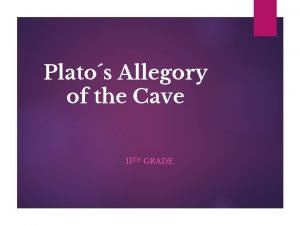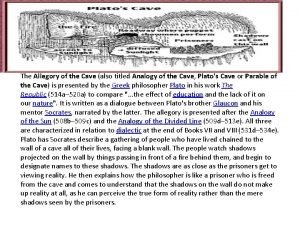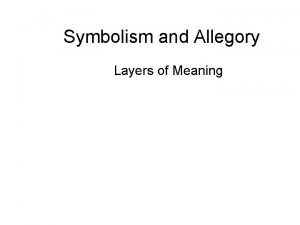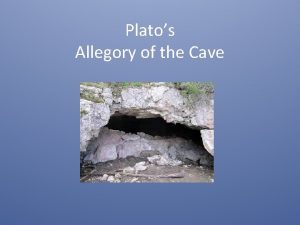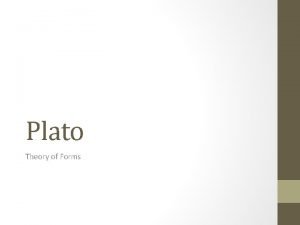The Allegory of the Cave also titled Analogy



![Re-read the top ¼ of the page [Page 70 (in 60 th Ed. )] Re-read the top ¼ of the page [Page 70 (in 60 th Ed. )]](https://slidetodoc.com/presentation_image_h/24957f94e321a8c2fed24c8064e9e885/image-4.jpg)

- Slides: 5

The Allegory of the Cave (also titled Analogy of the Cave, Plato's Cave or Parable of the Cave) is presented by the Greek philosopher Plato in his work The Republic (514 a– 520 a) to compare ". . . the effect of education and the lack of it on our nature". It is written as a dialogue between Plato's brother Glaucon and his mentor Socrates, narrated by the latter. The allegory is presented after the Analogy of the Sun (508 b– 509 c) and the Analogy of the Divided Line (509 d– 513 e). All three are characterized in relation to dialectic at the end of Books VII and VIII (531 d– 534 e). Plato has Socrates describe a gathering of people who have lived chained to the wall of a cave all of their lives, facing a blank wall. The people watch shadows projected on the wall by things passing in front of a fire behind them, and begin to designate names to these shadows. The shadows are as close as the prisoners get to viewing reality. He then explains how the philosopher is like a prisoner who is freed from the cave and comes to understand that the shadows on the wall do not make up reality at all, as he can perceive the true form of reality rather than the mere shadows seen by the prisoners.

https: //www. youtube. com/watch? v=d 2 afu. Tv. Uz. BQ

Plato’s Allegory of the Cave / Bradbury’s Fahrenheit 451 An allegory is a form of extended metaphor, in which objects, persons, and actions in a narrative, are equated with the meanings that lie outside the narrative itself. The underlying meaning has moral, social, religious, or political significance, and characters are often personifications of abstract ideas as charity, ignorance, greed, or envy. Thus an allegory is a story with two meanings, a literal meaning and a symbolic meaning.
![Reread the top ¼ of the page Page 70 in 60 th Ed Re-read the top ¼ of the page [Page 70 (in 60 th Ed. )]](https://slidetodoc.com/presentation_image_h/24957f94e321a8c2fed24c8064e9e885/image-4.jpg)
Re-read the top ¼ of the page [Page 70 (in 60 th Ed. )] – this is where Montag and Mildred argue over the value of books. Notice where Montag states that “books can get us half out of the cave”? "I've heard rumors; the world is starving, but we're well-fed. Is it true, the world works hard and we play? Is that why we're hated so much? I've heard the rumors about hate, too, once in a long while, over the years. Do you know why? I don't, that's sure! Maybe the books can get us half out of the cave. They just might stop us from making the same damn insane mistakes!" It is possible this is a reference to Plato’s Allegory of the Cave, in which all people are ignorant and stuck in cave together. The enlightened man is the man who removes his shackles and walks out of the cave into the real world. The idea here is that books are what enable us to do so.

The Allegory of the Cave parallels the story of Fahrenheit 451. The allegory symbolizes Bradbury’s story. Now, having seen & read the Allegory of the Cave, and having read Fahrenheit 451, please answer the following questions ► What is the prisoner’s original truth? Which character from Fahrenheit is most like the prisoner? How? ► What is the first reaction to freedom? Why? How does this connect to Montag? ► How do other prisoners react to the “truth” presented by the escaped prisoner? How does that connect to Fahrenheit 451? ► Why does the sun burn his eyes? Why is this a metaphor? Connect this to Montag.
